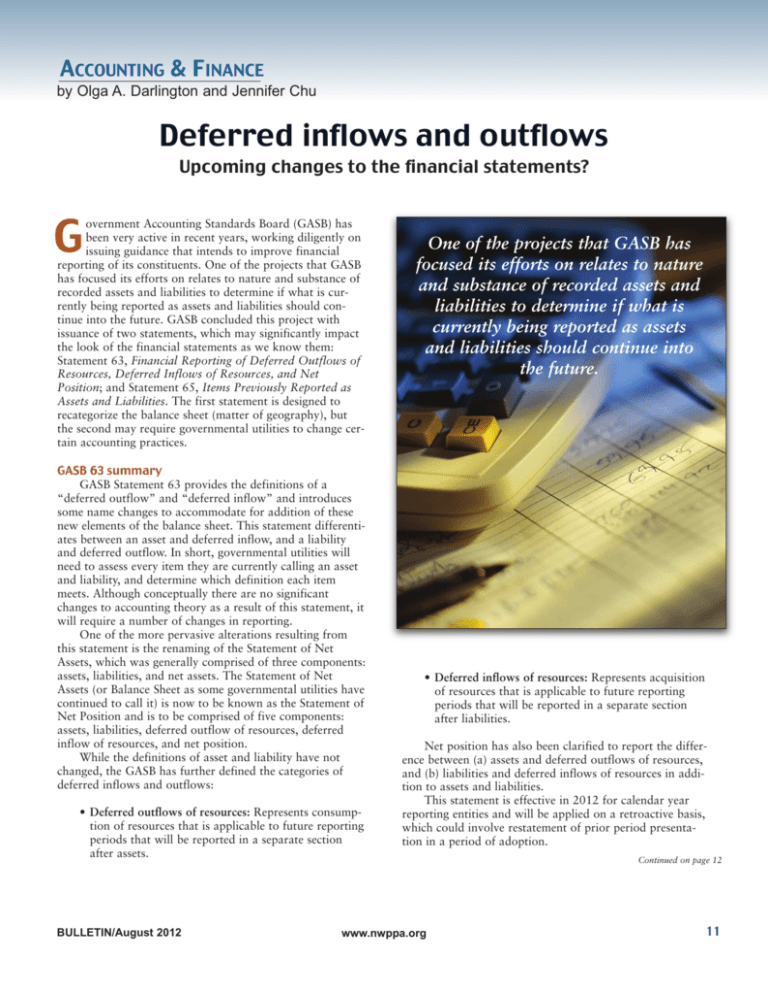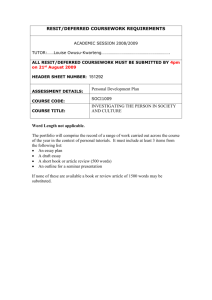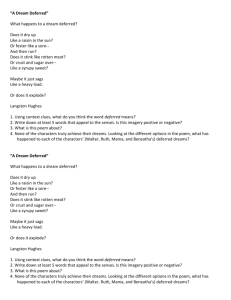Deferred inflows and outflows
advertisement

ACCOUNTING & FINANCE by Olga A. Darlington and Jennifer Chu Deferred inflows and outflows Upcoming changes to the financial statements? G overnment Accounting Standards Board (GASB) has been very active in recent years, working diligently on issuing guidance that intends to improve financial reporting of its constituents. One of the projects that GASB has focused its efforts on relates to nature and substance of recorded assets and liabilities to determine if what is currently being reported as assets and liabilities should continue into the future. GASB concluded this project with issuance of two statements, which may significantly impact the look of the financial statements as we know them: Statement 63, Financial Reporting of Deferred Outflows of Resources, Deferred Inflows of Resources, and Net Position; and Statement 65, Items Previously Reported as Assets and Liabilities. The first statement is designed to recategorize the balance sheet (matter of geography), but the second may require governmental utilities to change certain accounting practices. GASB 63 summary GASB Statement 63 provides the definitions of a “deferred outflow” and “deferred inflow” and introduces some name changes to accommodate for addition of these new elements of the balance sheet. This statement differentiates between an asset and deferred inflow, and a liability and deferred outflow. In short, governmental utilities will need to assess every item they are currently calling an asset and liability, and determine which definition each item meets. Although conceptually there are no significant changes to accounting theory as a result of this statement, it will require a number of changes in reporting. One of the more pervasive alterations resulting from this statement is the renaming of the Statement of Net Assets, which was generally comprised of three components: assets, liabilities, and net assets. The Statement of Net Assets (or Balance Sheet as some governmental utilities have continued to call it) is now to be known as the Statement of Net Position and is to be comprised of five components: assets, liabilities, deferred outflow of resources, deferred inflow of resources, and net position. While the definitions of asset and liability have not changed, the GASB has further defined the categories of deferred inflows and outflows: • Deferred outflows of resources: Represents consumption of resources that is applicable to future reporting periods that will be reported in a separate section after assets. BULLETIN/August 2012 One of the projects that GASB has focused its efforts on relates to nature and substance of recorded assets and liabilities to determine if what is currently being reported as assets and liabilities should continue into the future. • Deferred inflows of resources: Represents acquisition of resources that is applicable to future reporting periods that will be reported in a separate section after liabilities. Net position has also been clarified to report the difference between (a) assets and deferred outflows of resources, and (b) liabilities and deferred inflows of resources in addition to assets and liabilities. This statement is effective in 2012 for calendar year reporting entities and will be applied on a retroactive basis, which could involve restatement of prior period presentation in a period of adoption. www.nwppa.org Continued on page 12 11 ACCOUNTING & FINANCE incurred. The following activities are those common to the utility industry: • Debt issuance costs (other than insurance) • Initial costs incurred by the lessor in an operating lease • Acquisition costs for risk pools • Loan origination costs (other than the portion related to points) This statement is effective in 2013 for calendar year reporting entities and will also be applied on a retroactive basis resulting in potential restatements of prior periods presented. These standards do require retroactive reporting, which means that your accounting departments should start considering the impact of these standards as soon as possible. GASB 65 summary Whereas Statement 63 provided a technical definition of deferred outflow and inflow of resources, the question of what balances should be reclassified from currently presented assets and liabilities still remained. GASB Statement 65 identifies the items that can be defined as a deferred inflow or outflow in an effort to improve consistency between constituents. The following transactions most commonly transacted in the utility industry should now be classified as deferred inflows or outflows: • Deferred outflows of resources G Grant paid on advance of meeting time requirements G Deferred amounts from debt refunding or changes in lease obligations (debits) G Cost to acquire rights to future revenues (intraentity) G Deferred loss from sale-leaseback transactions • Deferred inflows of resources G Grants received in advance of meeting the timing requirement G Deferred amounts from debt refunding or changes in lease obligations (credits) G Proceeds from the sale of future revenue G Deferred gain from sale-leaseback transactions G “Regulatory” credits In addition, this Statement includes a list of items that should not be classified as a deferred inflow or outflow. The GASB has determined that these items should follow the route of period costs and be expensed in the period 12 Consideration of the impact The reporting changes required by Statements 63 and 65 present a number of unanswered questions, specifically surrounding debt issuance costs. Historically, utilities have been reporting these issuance costs as deferred debits on the balance sheet that are amortized over the life of the related debt. Given the substantial costs that many utilities pay in debt issuance, for many, expensing these costs in the period incurred could have significant impact on debt ratios and other compliance requirements. Going forward, should ratios be calculated differently? How will the financial community react to these changes? Would the need to comply with these requirements affect the transparency of issuance costs? In addition, depending on the size of the utility and its annual debt financing needs, the financial results could vary significantly from year to year requiring different management approaches to budgeting and rate-setting processes. Can your utility use regulatory accounting (FAS 71) to defer any costs not included in Statement 65? It is important to remember that Statement 63 is effective for 2012 reporting, while Statement 65 will become effective in 2013. This one year provides some time for careful consideration and analysis of balances historically recorded as deferred debits and credits. In preparation for year-end reporting, careful itemization should be completed for such balances and transactions that may, in fact, be assets and liabilities as defined by the standards. Once identified, these balances should be reclassified to more appropriate categories of assets and liabilities. Also note that gains and losses on debt refunding previously reported as offsets to the long-term debt balance will now be reported separately as deferred inflows/outflows. This change will affect the balance sheet reporting as well as extensive debt-related note disclosures. These standards do require retroactive reporting, which means that your accounting departments should start considering the impact of these standards as soon as possible. NWPPA Olga A. Darlington is a senior manager in the Everett office of Moss Adams LLP. Jennifer Chu is a business assurance manager in the Everett office as well. They can be reached at olga.darlington@mossadams.com and jennifer.chu@mossadams.com respectively. www.nwppa.org BULLETIN/August 2012


